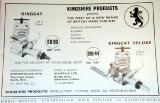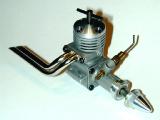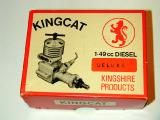Kingshire Products Kingcat
![]()
| Name | Kingcat | Designer | Kingshire Products |
| Type | Compression Ignition | Capacity | 1.48cc |
| Production run | unknown | Country of Origin | England |
| Photo by | Ron C | Year of manufacture | 1977 |
Notes:
 This delightfull little diesel was launched in Aeromodeller magazine of June 1977. The display add pictured here continued for another two issues. Thereafter, it appeared with a small picture in the "Performance Kits" display adds a couple of time before being downgraded to a simple text only line-item. It was also offered from various retialers advertising in Aeromodeller for a number of years, disappearing finally in early 1980. The story I've heard says that Kingshire Products was a private company who's owner/manager died unexpectedly, forcing the closure of the business. If true, this is sad as he (or his designer) certainly had a flair for producing attractive engines.
This delightfull little diesel was launched in Aeromodeller magazine of June 1977. The display add pictured here continued for another two issues. Thereafter, it appeared with a small picture in the "Performance Kits" display adds a couple of time before being downgraded to a simple text only line-item. It was also offered from various retialers advertising in Aeromodeller for a number of years, disappearing finally in early 1980. The story I've heard says that Kingshire Products was a private company who's owner/manager died unexpectedly, forcing the closure of the business. If true, this is sad as he (or his designer) certainly had a flair for producing attractive engines.
 Peter Chinn gave a mini-review of the engine in the February 1978 issue of Aeromodeller noting that the engine provided for review had been supplied by Kielkraft, noting they had "...recently taken on the distribution of Kingshire Products...". He reported that it started easily and ran well, and he hoped to publish a full test report later. As far as I've been able to research, this does not seem to have come to pass. In the September issue of the same year, Chinn gave a similar review of the new "Glow-Cat" from Kingshire Products. The engine shared the case castings of the diesel version, although as noted by Chinn, the crankshaft was larger in diameter, with a square rather than round inlet port and larger diameter gas passage. Again, an nice engine and with it's red head and matt grey case, it would be most attractive seen in color.
Peter Chinn gave a mini-review of the engine in the February 1978 issue of Aeromodeller noting that the engine provided for review had been supplied by Kielkraft, noting they had "...recently taken on the distribution of Kingshire Products...". He reported that it started easily and ran well, and he hoped to publish a full test report later. As far as I've been able to research, this does not seem to have come to pass. In the September issue of the same year, Chinn gave a similar review of the new "Glow-Cat" from Kingshire Products. The engine shared the case castings of the diesel version, although as noted by Chinn, the crankshaft was larger in diameter, with a square rather than round inlet port and larger diameter gas passage. Again, an nice engine and with it's red head and matt grey case, it would be most attractive seen in color.
 As can be seen from the adds, the Kingcat was available in two forms; standard and "delux"--the only difference being the inclusion of a set of chromed boy-racer exhaust pipes and an aluminium spinner-nut on the delux for an additional 1.48 UK pounds. The bore and stroke are given by Chinn as 0.501" and 0.460" respectively for a capacity of 0.0907 cuin, or 1.486cc. Close enough to the manufacturers' claim of 1.49cc (though I somehow doubt that Peter Chinn actually measured them). The general construction is more akin to a cross-flow glow engine. As can be seen in the Aeromodeller exploded views, a straight steel liner drops into a central casting, locating on a top flange. The case carries a single bypass bulge, with rear cover and front shaft housing attaching by four screws each. The cast-iron piston is flat topped and has a crescent cut-out on the front edge to clear the crank disk--necessary because of the compact, under-square design. The front-rotary induction shaft runs in a bronze busing and the prop drive washer is "splined" to the shaft. The conventional needle valve and spray bar mount into the venturi with a slight backwards slant.
As can be seen from the adds, the Kingcat was available in two forms; standard and "delux"--the only difference being the inclusion of a set of chromed boy-racer exhaust pipes and an aluminium spinner-nut on the delux for an additional 1.48 UK pounds. The bore and stroke are given by Chinn as 0.501" and 0.460" respectively for a capacity of 0.0907 cuin, or 1.486cc. Close enough to the manufacturers' claim of 1.49cc (though I somehow doubt that Peter Chinn actually measured them). The general construction is more akin to a cross-flow glow engine. As can be seen in the Aeromodeller exploded views, a straight steel liner drops into a central casting, locating on a top flange. The case carries a single bypass bulge, with rear cover and front shaft housing attaching by four screws each. The cast-iron piston is flat topped and has a crescent cut-out on the front edge to clear the crank disk--necessary because of the compact, under-square design. The front-rotary induction shaft runs in a bronze busing and the prop drive washer is "splined" to the shaft. The conventional needle valve and spray bar mount into the venturi with a slight backwards slant.
I have mixed feelings about this relatively common design feature. On an engine intended primarily for control line use, this slant does give some added finger clearence to the prop when the engine is mounted upright. But it effectively prevents the spray/needle from being reversed for inverted mounting in order to have the fuel attachment on the outside of the circle. Hence the fuel line has to snake from the outboard pickup, up-hill as it were (centrifugally speaking), to connect to the engine. So, good for beginners, and a right pain for the advanced user.
 There was evidentally a change, or an option in the Kingcat range at some time during its short life. The engine pictured here is from Ray Stranati's collection. While a "delux", the hot-rod exhaust has been replaced by a more normal expansion muffler, even though it is still fed by two short chromed pipe stubs from the same attachment manifold as previously. The body of the muffler is chromed steel, but the rear cover and exhaust pipe are turned from aluminium and pressed or glued in place. The downwards slant provides access to the mounting screws and lowers the center of mass of the combination. Also visible is the short spring wire needle friction "clicker". It is apparent that there was even a third version as the muffler provided with the Glow-Cat was different again.
There was evidentally a change, or an option in the Kingcat range at some time during its short life. The engine pictured here is from Ray Stranati's collection. While a "delux", the hot-rod exhaust has been replaced by a more normal expansion muffler, even though it is still fed by two short chromed pipe stubs from the same attachment manifold as previously. The body of the muffler is chromed steel, but the rear cover and exhaust pipe are turned from aluminium and pressed or glued in place. The downwards slant provides access to the mounting screws and lowers the center of mass of the combination. Also visible is the short spring wire needle friction "clicker". It is apparent that there was even a third version as the muffler provided with the Glow-Cat was different again.
 The packaging for the Kingcat is quite conventional. The box is from rather thin card stock without any internal support. A small, folded instruction leaflette gives adequate operational instruction for the beginner and quotes the bore as 0.501", exactly as reported by Chinn. I don't know how the piston liner fit was achieved. Both examples I've handled have excellent compression, so they were either hand finished, or had pistons and liners ground automatically with extreme precision. In any case, I'd expect a variation around the nominal 0.5" bore, hence my scepticism regarding Chinns echo of the manufacturer's figures (though it's not impossible). As was common on many British engines in the lower price categories, the serial number appears only on the Gurantee form, not the engine. This is unfortunate as a comparison between the number of Ray's muffled delux and my piped version migh give a clue to when this feature was introduced. A nice touch included with the papers is the note regarding the props used to factory test ansd set the compression screw (as long as it had not beed fiddled with by some ham-fisted shopper).
The packaging for the Kingcat is quite conventional. The box is from rather thin card stock without any internal support. A small, folded instruction leaflette gives adequate operational instruction for the beginner and quotes the bore as 0.501", exactly as reported by Chinn. I don't know how the piston liner fit was achieved. Both examples I've handled have excellent compression, so they were either hand finished, or had pistons and liners ground automatically with extreme precision. In any case, I'd expect a variation around the nominal 0.5" bore, hence my scepticism regarding Chinns echo of the manufacturer's figures (though it's not impossible). As was common on many British engines in the lower price categories, the serial number appears only on the Gurantee form, not the engine. This is unfortunate as a comparison between the number of Ray's muffled delux and my piped version migh give a clue to when this feature was introduced. A nice touch included with the papers is the note regarding the props used to factory test ansd set the compression screw (as long as it had not beed fiddled with by some ham-fisted shopper).
This is an engine that I recall taking a liking to when it first appeared, but at that time I was living and breathing main-frame computers 24 hours a day and had no spare cycles for modelling, otherwise I would probably have bought one. The example I have now I was lucky enough to pick up, new in box, over the Internet without having to enter any bidding frenzy. I'm well pleased with the little engine--they are still out there, if you're a bit lucky.
![]()



